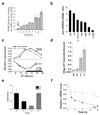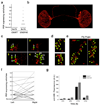Clk post-transcriptional control denoises circadian transcription both temporally and spatially
- PMID: 25952406
- PMCID: PMC4915573
- DOI: 10.1038/ncomms8056
Clk post-transcriptional control denoises circadian transcription both temporally and spatially
Abstract
The transcription factor CLOCK (CLK) is essential for the development and maintenance of circadian rhythms in Drosophila. However, little is known about how CLK levels are controlled. Here we show that Clk mRNA is strongly regulated post-transcriptionally through its 3' UTR. Flies expressing Clk transgenes without normal 3' UTR exhibit variable CLK-driven transcription and circadian behaviour as well as ectopic expression of CLK-target genes in the brain. In these flies, the number of the key circadian neurons differs stochastically between individuals and within the two hemispheres of the same brain. Moreover, flies carrying Clk transgenes with deletions in the binding sites for the miRNA bantam have stochastic number of pacemaker neurons, suggesting that this miRNA mediates the deterministic expression of CLK. Overall our results demonstrate a key role of Clk post-transcriptional control in stabilizing circadian transcription, which is essential for proper development and maintenance of circadian rhythms in Drosophila.
Conflict of interest statement
Figures







Similar articles
-
A role for microRNAs in the Drosophila circadian clock.Genes Dev. 2009 Sep 15;23(18):2179-91. doi: 10.1101/gad.1819509. Epub 2009 Aug 20. Genes Dev. 2009. PMID: 19696147 Free PMC article.
-
Genetic analysis of ectopic circadian clock induction in Drosophila.J Biol Rhythms. 2009 Oct;24(5):368-78. doi: 10.1177/0748730409343761. J Biol Rhythms. 2009. PMID: 19755582 Free PMC article.
-
Microarray analysis and organization of circadian gene expression in Drosophila.Cell. 2001 Nov 30;107(5):567-78. doi: 10.1016/s0092-8674(01)00545-1. Cell. 2001. PMID: 11733057
-
Circadian Rhythms and Sleep in Drosophila melanogaster.Genetics. 2017 Apr;205(4):1373-1397. doi: 10.1534/genetics.115.185157. Genetics. 2017. PMID: 28360128 Free PMC article. Review.
-
Transcriptional feedback loop regulation, function, and ontogeny in Drosophila.Cold Spring Harb Symp Quant Biol. 2007;72:437-44. doi: 10.1101/sqb.2007.72.009. Cold Spring Harb Symp Quant Biol. 2007. PMID: 18419302 Free PMC article. Review.
Cited by
-
mir-276a strengthens Drosophila circadian rhythms by regulating timeless expression.Proc Natl Acad Sci U S A. 2016 May 24;113(21):E2965-72. doi: 10.1073/pnas.1605837113. Epub 2016 May 9. Proc Natl Acad Sci U S A. 2016. PMID: 27162360 Free PMC article.
-
Heat the Clock: Entrainment and Compensation in Arabidopsis Circadian Rhythms.J Circadian Rhythms. 2019 May 14;17:5. doi: 10.5334/jcr.179. J Circadian Rhythms. 2019. PMID: 31139231 Free PMC article.
-
Emerging roles for microRNA in the regulation of Drosophila circadian clock.BMC Neurosci. 2018 Jan 16;19(1):1. doi: 10.1186/s12868-018-0401-8. BMC Neurosci. 2018. PMID: 29338692 Free PMC article. Review.
-
Translation of CircRNAs.Mol Cell. 2017 Apr 6;66(1):9-21.e7. doi: 10.1016/j.molcel.2017.02.021. Epub 2017 Mar 23. Mol Cell. 2017. PMID: 28344080 Free PMC article.
-
Circular RNAs exhibit exceptional stability in the aging brain and serve as reliable age and experience indicators.Cell Rep. 2025 Apr 22;44(4):115485. doi: 10.1016/j.celrep.2025.115485. Epub 2025 Apr 2. Cell Rep. 2025. PMID: 40184256 Free PMC article.
References
-
- Hall JC. Genetics and molecular biology of rhythms in Drosophila and other insects. Adv Genet. 2003;48:1–280. - PubMed
-
- Allada R, White NE, So WV, Hall JC, Rosbash M. A mutant Drosophila homolog of mammalian Clock disrupts circadian rhythms and transcription of period and timeless. Cell. 1998;93:791–804. - PubMed
-
- Rutila JE, et al. CYCLE is a second bHLH-PAS clock protein essential for circadian rhythmicity and transcription of Drosophila period and timeless. Cell. 1998;93:805–14. - PubMed
-
- Hardin PE, Hall JC, Rosbash M. Feedback of the Drosophila period gene product on circadian cycling of its messenger RNA levels. Nature. 1990;343:536–40. - PubMed
Publication types
MeSH terms
Substances
Grants and funding
LinkOut - more resources
Full Text Sources
Other Literature Sources
Molecular Biology Databases

